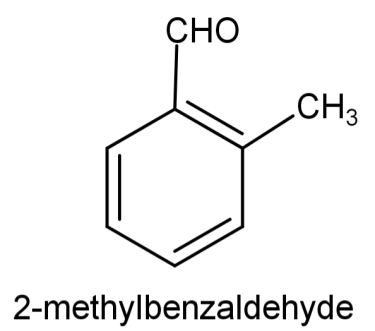
Answer
460.8k+ views
Hint: It is a carbonyl compound with no active hydrogen atoms or α-hydrogens. It has benzene parent carbon chain and oxidation product of 1,2-benzenedicarboxylic acid suggests that it has 2 substituents at 1 and 2 positions.
Complete step by step answer:
The molecular formula of the given compound is: ${C_8}{H_8}O$.
-Since the organic compound gives a 2,4 – DNP derivative, it means that it is a carbonyl compound because 2,4 – dinitrophenyl hydrazine (Brady’s reagent) reacts only with aldehydes and ketones to give a coloured precipitate.
Now we need to know whether the carbonyl group is of ketone or of aldehyde.
-This compound also reduces Tollen’s reagent and undergoes Cannizzaro reaction.
Tollen’s reagent is a solution of: silver nitrate ($AgN{O_3}$) and ammonia ($N{H_3}$) and is used for the detection of aldehydes. This reagent converts aldehydes to carboxylic acids. The general form of reaction by Tollen’s reagent is:
$R - COH + 2A{g^ + } + 2O{H^ - } \to R - COOH + 2Ag + {H_2}O$
Silver mirror-like surfaces on the test tube indicate the presence of an aldehydic group. Due to this reason, Tollen’s test is also known as the silver mirror test.
Cannizzaro reaction: It is a reaction to check for the presence of aldehydes which do not have any active hydrogen or α-hydrogen. Here the aldehyde reacts with a strong base to undergo a redox (oxidation-reduction) reaction. This converts aldehydes into alcohol and carboxylic acid. The general form of Cannizzaro reaction is:
$2R - CHO\xrightarrow[{{H_3}{O^ + }}]{{NaOH}}R - C{H_2}OH + R - COOH$
So, reducing Tollen’s reagent and giving Cannizzaro reaction means that there are no α-hydrogen and the compound has an aldehydic group.
So, this tells us that the compound will be a benzene ring with 2 substituents: an aldehydic group ($ - CHO$) and a methyl group ($ - C{H_3}$).
-Since vigorous oxidation of this compound gives 1,2-benzenedicarboxylic acid, so it proves that the aldehydic group ($ - CHO$) and the methyl group ($ - C{H_3}$) are present at successive positions.
So, the compound will be: 2-methylbenzaldehyde and its structure will be:

And the reactions involved will be:



So, the correct answer is “Option B”.
Note:Active hydrogens or α-hydrogens are those H atoms which are attached to the carbon atom just adjacent to the functional group carbon or to the α-carbon atom. Also the alpha hydrogen of carbonyl groups are highly acidic due to stability of the anion which will be formed once the hydrogen atom is removed.
Complete step by step answer:
The molecular formula of the given compound is: ${C_8}{H_8}O$.
-Since the organic compound gives a 2,4 – DNP derivative, it means that it is a carbonyl compound because 2,4 – dinitrophenyl hydrazine (Brady’s reagent) reacts only with aldehydes and ketones to give a coloured precipitate.
Now we need to know whether the carbonyl group is of ketone or of aldehyde.
-This compound also reduces Tollen’s reagent and undergoes Cannizzaro reaction.
Tollen’s reagent is a solution of: silver nitrate ($AgN{O_3}$) and ammonia ($N{H_3}$) and is used for the detection of aldehydes. This reagent converts aldehydes to carboxylic acids. The general form of reaction by Tollen’s reagent is:
$R - COH + 2A{g^ + } + 2O{H^ - } \to R - COOH + 2Ag + {H_2}O$
Silver mirror-like surfaces on the test tube indicate the presence of an aldehydic group. Due to this reason, Tollen’s test is also known as the silver mirror test.
Cannizzaro reaction: It is a reaction to check for the presence of aldehydes which do not have any active hydrogen or α-hydrogen. Here the aldehyde reacts with a strong base to undergo a redox (oxidation-reduction) reaction. This converts aldehydes into alcohol and carboxylic acid. The general form of Cannizzaro reaction is:
$2R - CHO\xrightarrow[{{H_3}{O^ + }}]{{NaOH}}R - C{H_2}OH + R - COOH$
So, reducing Tollen’s reagent and giving Cannizzaro reaction means that there are no α-hydrogen and the compound has an aldehydic group.
So, this tells us that the compound will be a benzene ring with 2 substituents: an aldehydic group ($ - CHO$) and a methyl group ($ - C{H_3}$).
-Since vigorous oxidation of this compound gives 1,2-benzenedicarboxylic acid, so it proves that the aldehydic group ($ - CHO$) and the methyl group ($ - C{H_3}$) are present at successive positions.
So, the compound will be: 2-methylbenzaldehyde and its structure will be:

And the reactions involved will be:



So, the correct answer is “Option B”.
Note:Active hydrogens or α-hydrogens are those H atoms which are attached to the carbon atom just adjacent to the functional group carbon or to the α-carbon atom. Also the alpha hydrogen of carbonyl groups are highly acidic due to stability of the anion which will be formed once the hydrogen atom is removed.
Recently Updated Pages
Identify the feminine gender noun from the given sentence class 10 english CBSE

Your club organized a blood donation camp in your city class 10 english CBSE

Choose the correct meaning of the idiomphrase from class 10 english CBSE

Identify the neuter gender noun from the given sentence class 10 english CBSE

Choose the word which best expresses the meaning of class 10 english CBSE

Choose the word which is closest to the opposite in class 10 english CBSE

Trending doubts
How do you graph the function fx 4x class 9 maths CBSE

Fill the blanks with the suitable prepositions 1 The class 9 english CBSE

Which are the Top 10 Largest Countries of the World?

A rainbow has circular shape because A The earth is class 11 physics CBSE

Change the following sentences into negative and interrogative class 10 english CBSE

The Equation xxx + 2 is Satisfied when x is Equal to Class 10 Maths

Give 10 examples for herbs , shrubs , climbers , creepers

Difference between Prokaryotic cell and Eukaryotic class 11 biology CBSE

One Metric ton is equal to kg A 10000 B 1000 C 100 class 11 physics CBSE




